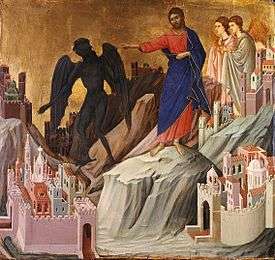Matthew 4:8

Matthew 4:8 is the eighth verse of the fourth chapter of the Gospel of Matthew in the New Testament. Jesus has just rejected Satan's second temptation. In this verse the devil transports Jesus to a new location for the third temptation.
The original Koine Greek, according to Westcott and Hort, reads:
- παλιν παραλαμβανει αυτον ο διαβολος εις ορος υψηλον λιαν και δεικνυσιν
- αυτω πασας τας βασιλειας του κοσμου και την δοξαν αυτων
In the King James Version of the Bible the text reads:
- Again, the devil taketh him up into an
- exceeding high mountain, and sheweth him all the
- kingdoms of the world, and the glory of them;
The World English Bible translates the passage as:
- Again, the devil took him to an exceedingly
- high mountain, and showed him all the
- kingdoms of the world, and their glory.
For a collection of other versions see BibRef Matthew 4:8
The Gospel of Luke does not mention a mountain. Luke 4:5 simply refers to a "high place." There is a mountain near Jericho that is popularly claimed to be the site of this temptation, but France notes there is no scriptural or historical evidence to support this.[1] There is a possible a link between this verse and Moses viewing the Holy Land in at Deuteronomy 3:27 and Deuteronomy 34:1-4, but Nolland does not think such a link is sensical.[2]
There is, of course, no mountain from where "all the kingdoms of the world" can be seen. One explanation for this is that the word taketh does not necessarily refer to a physical transportation, it could mean that Satan merely took Jesus in a vision. John Calvin supported this view, and the Geneva Bible made this interpretation explicit. Clarke lists several other explanation that have been given for this statement:[3]
- The world only refers to the "known world" of that time and people, or is a general expression referring to the local region, which could be seen from a mountain.
- The word kingdom does not refer to geographical entities, but is rather a metaphor for earthly power.
- The showing did not itself take place on the mountain, rather the actual "showing" consisted of a rapid fly over of the entire world.
- Once atop the mountain the devil did not literally show Jesus the kingdoms but rather pulled out a map upon which all the kingdoms were displayed.
- Fortna also notes that the verse could be implying a Flat Earth, which would allow for all countries to be seen at once from a tall enough mountain.[4]
Clark notes that the mountain setting evokes pagan mythology, which often had to gods atop mountains of extreme height. The most famous example being Mount Olympus of the Greeks.[5] The deuterocanonical Book of Baruch also mentions a mountain from where all the kingdoms of the Earth can be seen.[6]
Nolland contrasts the"kingdoms of the world" to the "Kingdom of Heaven" that is mentioned throughout the Gospel, one being the kingdom of Satan and the other the kingdom of God.[7]
This verse is often considered to be a reference to Deuteronomy 32:49, where God instructs Moses to climb Mount Nebo and shows him Jericho and Canaan and promises them to the Israelites. This verse shows that Jesus' domain is greater, as he is presented with the entire world. France notes that it also implies that the devil then had control of the entire globe prior to the coming of Jesus, something made explicit in Luke 4:6 and John 12:31.[8]
References
- ↑ France, R.T.. The Gospel of Matthew. Wm. B. Eerdmans Publishing, 2007 pg. 134
- ↑ Nolland, John. The Gospel of Matthew: a commentary on the Greek text. Wm. B. Eerdmans Publishing, 2005 pg. 166
- ↑ Clarke, Howard W. The Gospel of Matthew and its Readers: A Historical Introduction to the First Gospel. Bloomington: Indiana University Press, 2003.
- ↑ Fortna, Robert. The Gospel of Matthew - Scholars Bible Polebridge Press, 2005 pg. 49
- ↑ Clarke, Howard W. The Gospel of Matthew and its Readers: A Historical Introduction to the First Gospel. Bloomington: Indiana University Press, 2003.
- ↑ France, R.T.. The Gospel of Matthew. Wm. B. Eerdmans Publishing, 2007 pg. 134
- ↑ Nolland, John. The Gospel of Matthew: a commentary on the Greek text. Wm. B. Eerdmans Publishing, 2005 pg. 166
- ↑ France, R.T. The Gospel According to Matthew: an Introduction and Commentary. Leicester: Inter-Varsity, 1985.
| Preceded by Matthew 4:7 |
Gospel of Matthew Chapter 4 |
Succeeded by Matthew 4:9 |